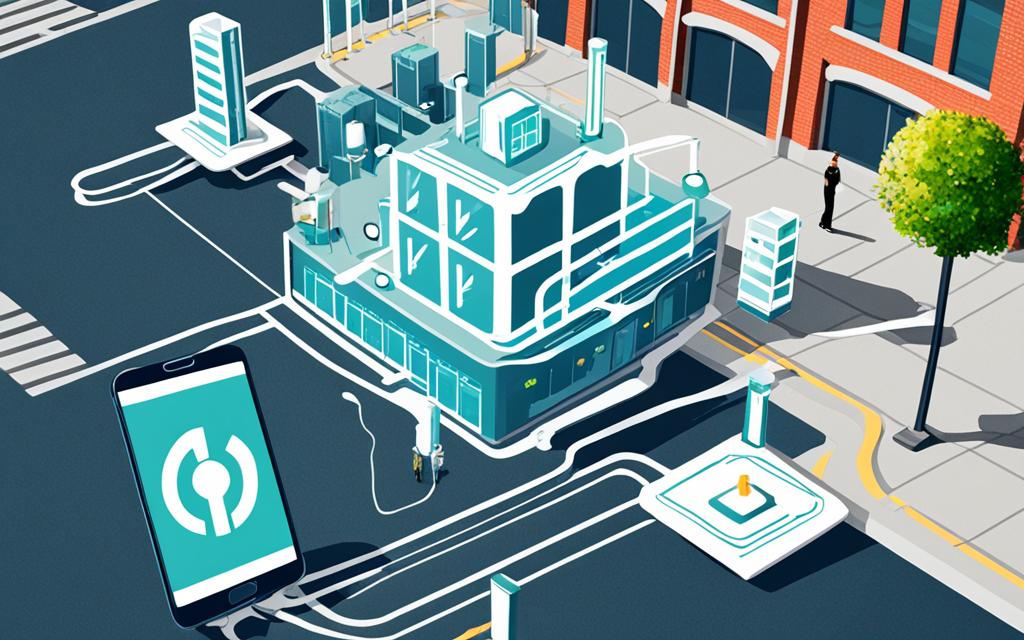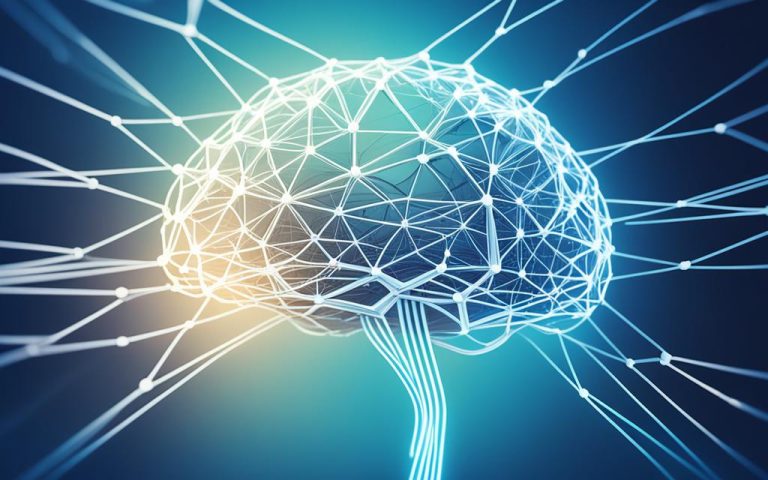In today’s fast-paced digital era, the demand for real-time data processing and network efficiency continues to grow. To meet these challenges, professionals in the telecommunications industry are increasingly turning to edge computing in cellular networks. Edge computing is a revolutionary approach that brings data processing closer to the source, improving network efficiency and enabling faster decision-making.
Edge computing addresses the need to handle vast amounts of data collected in real-time from sensors and Internet of Things (IoT) devices in various locations. By moving storage and compute resources closer to the data source, edge computing optimizes data processing, reduces latency, and enhances network efficiency. This decentralized IT architecture enables organizations to gain real-time insights and conduct business operations more effectively.
With edge computing, the power of data processing lies at the edge of the network, eliminating the need to transmit raw data to a central data center for analysis. Instead, data is processed and analyzed at the edge, near the data source. Only the results of the analysis are sent back to the main data center. This approach significantly reduces latency and ensures rapid response times, critical factors in today’s data-intensive environment.
Edge computing is crucial for network efficiency and optimization in various industries, including healthcare, manufacturing, transportation, and smart cities. It enables the implementation of time-sensitive applications such as self-driving cars and telesurgery, where real-time data processing is essential. By bringing data closer, edge computing enhances privacy and security, reduces bandwidth usage, and enables faster and more accurate decision-making.
In the following sections, we will explore in more detail what edge computing is, how it works, and its distinct advantages over cloud and fog computing. We will also delve into the importance of edge computing and its role in smart cities, where real-time insights and efficient data processing are vital for effective urban development.
What is Edge Computing and How Does it Work?
Edge computing is a revolutionary approach to data processing that brings storage and compute resources closer to the source of data generation. Unlike traditional computing models where data travels long distances to a centralized data center for processing and analysis, edge computing performs these tasks at the edge of the network, near the data source itself.
By utilizing distributed computing, edge computing minimizes latency and optimizes data processing efficiency. It enables real-time decision-making by processing data at the edge, where it is generated, rather than transmitting it to a remote data center.
The architecture of edge computing can be visualized as a network of interconnected devices that form an edge ecosystem. These devices, such as edge servers, gateways, and IoT devices, work collaboratively to perform data processing tasks locally, eliminating the need for round-trip data transfers.
Here’s how edge computing works:
- Data from sensors, IoT devices, and other sources is collected and processed locally at the edge nodes.
- Edge nodes perform data filtering, aggregation, and preliminary analysis based on predefined rules or machine learning algorithms.
- Only the results of the analysis or relevant data subsets are transmitted to the central data center for further processing or storage.
- Real-time insights and actionable information are generated at the edge, enabling timely decision-making without relying on distant data centers.
This distributed computing model offers numerous benefits, such as:
- Reduced Latency: Edge computing significantly reduces the time it takes for data to travel between the data source and the point of analysis, enabling near real-time processing.
- Enhanced Data Processing: By processing data locally, edge computing minimizes bandwidth usage and optimizes network resources, allowing for faster and more efficient data analysis.
- Improved Reliability: Edge computing helps ensure uninterrupted data processing even in the event of network disruptions, enhancing overall system reliability.
- Scalability: Distributed edge nodes can be easily added or removed to accommodate changing data processing requirements, making edge computing a highly scalable solution.
“Edge computing moves storage and compute resources from the central data center to the location where data is generated.”
The image below illustrates the concept of edge computing:
Edge computing revolutionizes the way data is processed and analyzed by bringing computation capabilities closer to the source, thereby enabling real-time insights, reducing latency, and enhancing overall network efficiency.
Edge Computing vs. Cloud and Fog Computing
Edge computing, cloud computing, and fog computing are closely related concepts but have distinct characteristics. Let’s take a closer look at each:
Edge Computing
Edge computing deploys compute and storage resources at the location of data generation. This approach allows for real-time processing and analysis of data at the edge, near the data source. By minimizing data transmission back to a central data center, edge computing reduces latency and enhances efficiency in data processing.
Cloud Computing
Cloud computing, on the other hand, provides scalable resources in distributed global locations. It involves the centralization of compute and storage in data centers, enabling users to access computing resources over the internet. Cloud computing offers flexibility, scalability, and cost-effectiveness for various applications and services.
Fog Computing
Fog computing operates within a larger environment to collect, process, and analyze data from multiple edge nodes. It serves as an intermediate layer between the edge and the cloud, allowing for localized data processing close to the edge while also leveraging cloud resources for more complex tasks. Fog computing provides a balance between edge and cloud computing, enabling efficient data management and analysis.
Edge computing deploys compute and storage resources at the location of data generation, while cloud computing provides scalable resources in distributed global locations. Fog computing operates within a larger environment to collect, process, and analyze data from multiple edge nodes.
Each approach, edge computing, cloud computing, fog computing, has its unique use cases and advantages. The choice depends on several factors such as data volume, latency requirements, and connectivity:
- Edge computing is ideal for applications requiring real-time decision-making, low latency, and efficient data processing at the edge.
- Cloud computing offers scalability, cost-effectiveness, and centralized management of compute resources for applications that do not require real-time processing at the edge.
- Fog computing strikes a balance between edge and cloud computing, providing localized data processing and leveraging cloud resources for more complex tasks.
To visualize the comparisons between edge computing, cloud computing, and fog computing, refer to the table below:
| Edge Computing | Cloud Computing | Fog Computing |
|---|---|---|
| Deployed at the location of data generation | Offers scalable resources in distributed global locations | Collects, processes, and analyzes data from multiple edge nodes |
| Enables real-time processing and low latency | Provides scalability, cost-effectiveness, and centralized management | Offers a balance between edge and cloud computing |
| Ideal for time-sensitive applications | Beneficial for non-real-time processing applications | Optimizes data management and analysis |

The Importance of Edge Computing
Edge computing plays a vital role in addressing the challenges of processing and transmitting large volumes of data in real-time. By deploying compute and storage resources closer to the data source, edge computing offers numerous benefits that are essential for modern networks and industries.
Reduced Latency and Rapid Response Times
One of the key advantages of edge computing is its ability to significantly reduce latency. By processing and analyzing data closer to where it is generated, edge computing minimizes the time it takes for information to travel back and forth between the data source and central data centers. This results in faster response times and improved overall system performance.
Improved Network Efficiency
Edge computing enhances network efficiency by reducing the volume of data that needs to be transmitted across the network. Instead of sending raw data back to a central data center for processing, edge computing enables data processing and analysis to be performed at the edge. This eliminates the need for large data transfers, conserves network bandwidth, and optimizes resource utilization.
Enhanced Privacy and Security
With edge computing, sensitive and critical data can be processed locally, closer to the source, rather than being transmitted and stored in remote data centers. This reduces the exposure of data to potential security breaches during transmission and central storage. It also enhances privacy by minimizing the amount of data that leaves the edge devices, improving data governance and compliance.
Enablement of Time-Sensitive Applications
Edge computing enables the implementation of time-sensitive applications that require real-time processing and decision-making. Industries such as autonomous vehicles and telesurgery heavily rely on edge computing to ensure immediate and precise responses. By bringing compute resources closer to the data source, edge computing enables these applications to function seamlessly and effectively.
“Edge computing minimizes latency, enhances network efficiency, and enables rapid response times.”
Edge computing is revolutionizing industries by providing a scalable and efficient solution for data processing. The ability to process data at the edge not only improves performance but also opens up new possibilities for real-time insights, advanced analytics, and intelligent decision-making.
By combining the power of distributed computing with data processing capabilities, edge computing is paving the way for the advancement of various industries, including manufacturing, healthcare, transportation, and smart cities.
| Advantages of Edge Computing | Examples |
|---|---|
| Reduced latency and rapid response times | Real-time monitoring of critical infrastructure |
| Improved network efficiency | Efficient management of IoT devices in smart homes |
| Enhanced privacy and security | Local processing of personal health data in wearables |
| Enablement of time-sensitive applications | Real-time traffic management systems |
Edge Computing in Smart Cities
Smart cities are continuously harnessing technological advancements to improve the quality of life for their residents and enhance urban operations. One of the key technologies driving this transformation is edge computing, which plays a pivotal role in processing data at the periphery of the network, closer to where it is generated.
This approach significantly improves the efficiency, speed, and reliability of various smart city applications, enabling real-time insights and enhanced decision-making. Edge computing is utilized in several critical areas of smart city development, including:
Traffic Management
- Intelligent traffic control systems rely on edge computing to process data from countless sensors and cameras across the city. By analyzing real-time traffic patterns, congestion points, and accident detection, edge computing enables efficient traffic management and optimized routing.
Public Safety
- Smart cities deploy edge computing to support public safety initiatives, such as video surveillance, facial recognition, and real-time analytics. This enables law enforcement agencies to identify potential threats, respond swiftly to emergencies, and ensure the safety of citizens.
Energy Management
- Edge computing empowers smart energy grids by processing data from smart meters, remote sensors, and renewable energy sources in real-time. It enables precise energy consumption monitoring, load balancing, and optimization, contributing to energy efficiency and sustainability.
Environmental Monitoring
- Edge computing is instrumental in monitoring and analyzing environmental factors, such as air quality, noise levels, and weather conditions. With real-time insights, smart cities can take prompt actions to mitigate pollution, enhance public health, and improve overall environmental quality.
The deployment of edge computing in smart cities offers various advantages, including reduced latency, enhanced privacy and security, and the ability to provide real-time insights for effective urban development. By processing data closer to the source, edge computing eliminates the need for transmitting large volumes of data to centralized data centers, ensuring faster response times and minimizing network congestion.
“Edge computing in smart cities unlocks the potential for more efficient and sustainable urban environments, where data-driven decisions can be made promptly to address current challenges and plan for the future,” says Dr. Sarah Kim, a renowned expert in urban planning and smart city technologies.

With the power of edge computing, cities can generate real-time insights that fuel innovation and drive transformative change. The ability to process and analyze data on the edge enables smart cities to implement intelligent systems, deploy self-driving vehicles, optimize energy consumption, and deliver a multitude of other services that enhance the well-being of citizens.
Edge computing is poised to revolutionize the way smart cities operate, providing a solid foundation for the future of urban development. As more cities embrace this technology, the potential for creating sustainable, efficient, and livable environments becomes increasingly attainable.
Conclusion
Edge computing revolutionizes data processing by bringing it closer to the source, resulting in improved network efficiency and real-time insights. With reduced latency and enhanced privacy and security, edge computing offers significant advantages for organizations seeking faster and more efficient data processing.
By deploying compute and storage resources at the edge of the network, edge computing optimizes bandwidth usage and ensures rapid response times. The scalability of edge computing allows for seamless integration with existing infrastructures, making it a versatile solution for various industries.
Although implementing edge computing in smart cities poses certain challenges, such as infrastructure requirements and interoperability, it is a crucial technology for building smarter and more efficient urban environments. The integration of edge computing into urban infrastructures will unlock the full potential of IoT technologies, enabling real-time data processing, and facilitating the development of innovative smart city applications.
FAQ
What is edge computing?
Edge computing is a distributed IT architecture that processes client data at the periphery of the network, close to the source.
How does edge computing work?
Edge computing moves storage and compute resources from the central data center to the location where data is generated. It performs data processing and analysis at the edge, near the data source, and only sends back the results to the main data center.
How is edge computing different from cloud and fog computing?
Edge computing deploys compute and storage resources at the location of data generation, while cloud computing offers scalable resources in distributed global locations. Fog computing operates within a larger environment to collect, process, and analyze data from multiple edge nodes.
Why is edge computing important?
Edge computing reduces latency, improves network efficiency, enhances privacy and security, and enables real-time decision-making. It provides a solution to the challenges of processing and transmitting large volumes of data in real-time.
How does edge computing benefit smart cities?
Edge computing processes data at the periphery of the network, improving the efficiency, speed, and reliability of smart city applications. It is used for traffic management, public safety, energy management, and environmental monitoring in smart cities.
What advantages does edge computing offer?
Edge computing offers advantages such as reduced latency, bandwidth efficiency, enhanced privacy and security, and scalability. It brings data processing closer to the source, enabling real-time insights and decision-making.



















